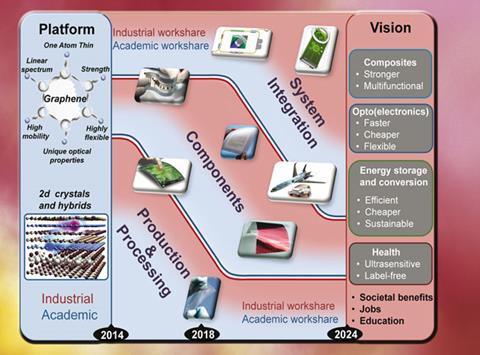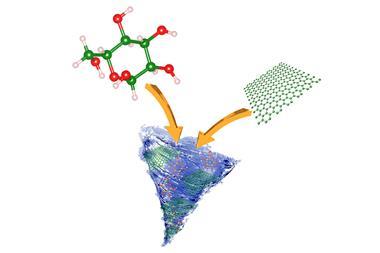Scientists hope their comprehensive roadmap will help tease out graphene’s potential

As a simple hexagonal lattice of carbon atoms, graphene provides a highly electronic and thermally conductive surface that is also the strongest and thinnest material known to man. It is foldable and can be modified to make novel materials with tuneable properties. This combination of valuable properties in a single material is what makes graphene special.
Graphene was first produced in measurable quantities at the start of the century but only recently has research really started to exploit the material as scientists better understand its fundamental properties and investigate ways to overcome intrinsic limitations, like its lack of band gap, that are getting in the way of its wide-scale application. Over 16,000 papers were published in the field in 2014, with graphene featuring in everything from chemical sensors and medical devices to solar cells and batteries. To date, multinational electronics company Samsung has almost 700 graphene-related patents.
Flatland of opportunity
Recognising the promise of graphene and the challenge of driving such a diverse field of research, the European Union launched the Graphene Flagship in 2013, its biggest ever research initiative. The flagship aims to bring academic and industrial researchers together to increase the commercial output of graphene research and realise disruptive technologies. It has a €1 billion budget and one of their first tasks was to produce a roadmap.
Coordinator of the roadmap Andrea Ferrari, from the University of Cambridge, explains that applied graphene research is only a recent occurrence, prior to that most had been fundamental and on its basic physics. He highlights that graphene is at the start of its investment and new materials typically take 20–40 years to move from the laboratory to the factory floor: ‘So it is really only around 2024 that we can ask ourselves if graphene is really showing its potential.’

The roadmap is split into 11 science and technology themes including spintronics, biomedical devices and energy conversion and storage. Short-, medium- and long-term targets for technological milestones as well as safety profiles sit alongside the plethora of potential applications. Core research is only summarised but at 213 pages, and with over 2300 references, the roadmap is one of the longest articles ever published by the Royal Society of Chemistry.
Karl Coleman an expert in graphene at Durham University says ‘a science and technology roadmap of any material is difficult but graphene, and indeed all 2D materials, is made more difficult as the area is moving extremely quickly. It is therefore very difficult to predict how things will develop.’ He is sure that industry will find this roadmap extremely useful, as will academics looking for an overview of the area.
Replacing existing materials just for the sake of it is not a priority. Rather, the roadmap team hope graphene’s unique properties will act as a gateway to as yet undiscovered materials that yield further interesting properties
The roadmap will be updated every two years to keep the community abreast of important developments, with the next version being prepared for release in March 2016.
References
The roadmap is open access. Download it here:












No comments yet